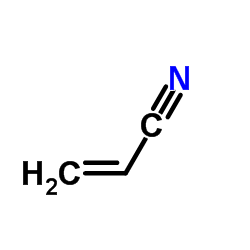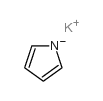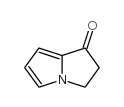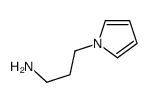43036-06-2
| 中文名 | N-2-氰乙基吡咯 |
|---|---|
| 英文名 | n-(2-cyanoethyl)pyrrole |
| 中文别名 |
1-吡咯丙腈
1-(2-氰基乙基)吡咯 N-(2-氰基乙基)吡咯 |
| 英文别名 |
pyrrole-1-propionitrile
MFCD00003092 3-(1H-Pyrrol-1-yl)propanenitrile N-(2-Cyanoethyl)pyrrole EINECS 256-051-6 N-(2-Cyanoethyl)-pyrrole 1H-Pyrrole-1-propanenitrile 3-pyrrol-1-ylpropanenitrile |
| 密度 | 1.0±0.1 g/cm3 |
|---|---|
| 沸点 | 266.8±0.0 °C at 760 mmHg |
| 分子式 | C7H8N2 |
| 分子量 | 120.152 |
| 闪点 | 104.4±22.6 °C |
| 精确质量 | 120.068748 |
| PSA | 28.72000 |
| LogP | 0.70 |
| 外观性状 | 透明略黄色至棕色液体 |
| 蒸汽压 | 0.0±0.5 mmHg at 25°C |
| 折射率 | 1.527 |
| 储存条件 | 密封、阴凉、干燥保存 |
| 稳定性 | 常规情况下不会分解,没有危险反应 |
| 计算化学 | 1.疏水参数计算参考值(XlogP):0.3 2.氢键供体数量:0 3.氢键受体数量:1 4.可旋转化学键数量:2 5.互变异构体数量:无 6.拓扑分子极性表面积28.7 7.重原子数量:9 8.表面电荷:0 9.复杂度:116 10.同位素原子数量:0 11.确定原子立构中心数量:0 12.不确定原子立构中心数量:0 13.确定化学键立构中心数量:0 14.不确定化学键立构中心数量:0 15.共价键单元数量:1 |
| 更多 | 1. 性状:液体 2. 密度(g/mL,25ºC):1.040 3. 相对蒸汽密度(g/mL,空气=1):未确定 4. 熔点(ºC):未确定 5. 沸点(ºC):未确定 6. 沸点(ºC,10mm hg):132-133 7. 折射率:n 20/D 1.51(lit.) 8. 闪点(ºC):> 112 9. 比旋光度(ºC):未确定 10. 自燃点或引燃温度(ºC): 未确定 11. 蒸气压(kPa,20ºC):未确定 12. 饱和蒸气压(kPa,60ºC):未确定 13. 燃烧热(KJ/mol):未确定 14. 临界温度(ºC):未确定 15. 临界压力(KPa):未确定 16. 油水(辛醇/水)分配系数的对数值:未确定 17. 爆炸上限(%,V/V):未确定 18. 爆炸下限(%,V/V):未确定 19. 溶解性:未确定 |
Synonym:1-Pyrrolepropionitrile; 1-(2-Cyanoethyl)pyrrole; 3-(Pyrrol-1-yl)propiononitrile Section 2 - COMPOSITION, INFORMATION ON INGREDIENTS
Risk Phrases: 20/21 Section 3 - HAZARDS IDENTIFICATION EMERGENCY OVERVIEW
Harmful by inhalation and in contact with skin. Potential Health Effects Eye: Causes eye irritation. Skin: Causes skin irritation. May be harmful if absorbed through the skin. Ingestion: May cause irritation of the digestive tract. May be harmful if swallowed. Inhalation: Causes respiratory tract irritation. May be harmful if inhaled. Chronic: May be metabolized to cyanide which in turn acts by inhibiting cytochrome oxidase impairing cellular respiration. Chronic exposure to cyanide solutions may lead to the development of a "cyanide" rash, characterized by itching, and by macular, papular, and vesicular eruptions, and may be accompanied by secondary infections. Exposure to small amounts of cyanide compounds over long periods of time is reported to cause loss of appetite, headache, weakness, nausea, dizziness, and symptoms of irritation of the upper respiratory tract and eyes. Section 4 - FIRST AID MEASURES Eyes: Flush eyes with plenty of water for at least 15 minutes, occasionally lifting the upper and lower eyelids. Get medical aid. Skin: Get medical aid. Flush skin with plenty of water for at least 15 minutes while removing contaminated clothing and shoes. Wash clothing before reuse. Ingestion: Never give anything by mouth to an unconscious person. Get medical aid. Do NOT induce vomiting. If conscious and alert, rinse mouth and drink 2-4 cupfuls of milk or water. Inhalation: Remove from exposure and move to fresh air immediately. If not breathing, give artificial respiration. If breathing is difficult, give oxygen. Get medical aid. Notes to Physician: Section 5 - FIRE FIGHTING MEASURES General Information: As in any fire, wear a self-contained breathing apparatus in pressure-demand, MSHA/NIOSH (approved or equivalent), and full protective gear. During a fire, irritating and highly toxic gases may be generated by thermal decomposition or combustion. Use water spray to keep fire-exposed containers cool. Vapors may be heavier than air. They can spread along the ground and collect in low or confined areas. Containers may explode when heated. Extinguishing Media: Do NOT get water inside containers. For small fires, use dry chemical, carbon dioxide, or water spray. For large fires, use dry chemical, carbon dioxide, alcohol-resistant foam, or water spray. Cool containers with flooding quantities of water until well after fire is out. Section 6 - ACCIDENTAL RELEASE MEASURES General Information: Use proper personal protective equipment as indicated in Section 8. Spills/Leaks: Absorb spill with inert material (e.g. vermiculite, sand or earth), then place in suitable container. Avoid runoff into storm sewers and ditches which lead to waterways. Clean up spills immediately, observing precautions in the Protective Equipment section. Provide ventilation. Section 7 - HANDLING and STORAGE Handling: Wash thoroughly after handling. Use with adequate ventilation. Avoid contact with eyes, skin, and clothing. Keep container tightly closed. Avoid ingestion and inhalation. Storage: Store in a tightly closed container. Store in a cool, dry, well-ventilated area away from incompatible substances. Section 8 - EXPOSURE CONTROLS, PERSONAL PROTECTION Engineering Controls: Facilities storing or utilizing this material should be equipped with an eyewash facility and a safety shower. Use adequate ventilation to keep airborne concentrations low. Exposure Limits CAS# 43036-06-2: Personal Protective Equipment Eyes: Wear chemical splash goggles. Skin: Wear appropriate protective gloves to prevent skin exposure. Clothing: Wear appropriate protective clothing to prevent skin exposure. Respirators: A respiratory protection program that meets OSHA's 29 CFR 1910.134 and ANSI Z88.2 requirements or European Standard EN 149 must be followed whenever workplace conditions warrant respirator use. Section 9 - PHYSICAL AND CHEMICAL PROPERTIES Physical State: Liquid Color: clear yellow Odor: none reported pH: Not available. Vapor Pressure: Not available. Viscosity: Not available. Boiling Point: 132-133 deg C @ 10 mmHg Freezing/Melting Point: Not available. Autoignition Temperature: Not available. Flash Point: > 112 deg C (> 233.60 deg F) Explosion Limits, lower: Not available. Explosion Limits, upper: Not available. Decomposition Temperature: Solubility in water: Specific Gravity/Density: 1.0480g/cm3 Molecular Formula: C7H8N2 Molecular Weight: 120.15 Section 10 - STABILITY AND REACTIVITY Chemical Stability: Stable at room temperature in closed containers under normal storage and handling conditions. Conditions to Avoid: Excess heat. Incompatibilities with Other Materials: Strong oxidizing agents. Hazardous Decomposition Products: Hydrogen cyanide, carbon monoxide, oxides of nitrogen, carbon dioxide. Hazardous Polymerization: Has not been reported Section 11 - TOXICOLOGICAL INFORMATION RTECS#: CAS# 43036-06-2 unlisted. LD50/LC50: Not available. Carcinogenicity: N-(2-Cyanoethyl)pyrrole - Not listed by ACGIH, IARC, or NTP. Section 12 - ECOLOGICAL INFORMATION Section 13 - DISPOSAL CONSIDERATIONS Dispose of in a manner consistent with federal, state, and local regulations. Section 14 - TRANSPORT INFORMATION IATA Shipping Name: TOXIC LIQUID, ORGANIC, N.O.S.* Hazard Class: 6.1 UN Number: 2810 Packing Group: I IMO Shipping Name: TOXIC LIQUID, ORGANIC, N.O.S. Hazard Class: 6.1 UN Number: 2810 Packing Group: I RID/ADR Shipping Name: TOXIC LIQUID, ORGANIC, N.O.S. Hazard Class: 6.1 UN Number: 2810 Packing group: I Section 15 - REGULATORY INFORMATION European/International Regulations European Labeling in Accordance with EC Directives Hazard Symbols: XN Risk Phrases: R 20/21 Harmful by inhalation and in contact with skin. Safety Phrases: S 23 Do not inhale gas/fumes/vapour/spray. S 28A After contact with skin, wash immediately with plenty of water. S 37 Wear suitable gloves. S 45 In case of accident or if you feel unwell, seek medical advice immediately (show the label where possible). WGK (Water Danger/Protection) CAS# 43036-06-2: No information available. Canada None of the chemicals in this product are listed on the DSL/NDSL list. CAS# 43036-06-2 is not listed on Canada's Ingredient Disclosure List. US FEDERAL TSCA CAS# 43036-06-2 is not listed on the TSCA inventory. It is for research and development use only. SECTION 16 - ADDITIONAL INFORMATION N/A |
|
生态学数据: 对水是稍微有危害的不要让未稀释或大量的产品接触地下水、水道或者污水系统,若无政府许可,勿将材料排入周围环境。
|
| 危害码 (欧洲) | Xn: Harmful; |
|---|---|
| 风险声明 (欧洲) | R20/21 |
| 安全声明 (欧洲) | S23 |
| 危险品运输编码 | UN 2810 |
| 海关编码 | 2933990090 |
|
~87% 
43036-06-2 |
| 文献:Taylor, James E.; Jones, Matthew D.; Williams, Jonathan M. J.; Bull, Steven D. Organic Letters, 2010 , vol. 12, # 24 p. 5740 - 5743 |
|
~30% 
43036-06-2 |
| 文献:Dieltiens, Nicolai; Stevens, Christian V.; Vos, David De; Allaert, Bart; Drozdzak, Renata; Verpoort, Francis Tetrahedron Letters, 2004 , vol. 45, # 49 p. 8995 - 8998 |
|
~% 
43036-06-2 |
| 文献:Herz et al. Journal of Organic Chemistry, 1956 , vol. 21, p. 896 |
|
~% 
43036-06-2 |
| 文献:Clemo; Ramage Journal of the Chemical Society, 1931 , p. 49,54 |
| 上游产品 6 | |
|---|---|
| 下游产品 5 | |
| 海关编码 | 2933990090 |
|---|---|
| 中文概述 | 2933990090. 其他仅含氮杂原子的杂环化合物. 增值税率:17.0%. 退税率:13.0%. 监管条件:无. 最惠国关税:6.5%. 普通关税:20.0% |
| 申报要素 | 品名, 成分含量, 用途, 乌洛托品请注明外观, 6-己内酰胺请注明外观, 签约日期 |
| Summary | 2933990090. heterocyclic compounds with nitrogen hetero-atom(s) only. VAT:17.0%. Tax rebate rate:13.0%. . MFN tariff:6.5%. General tariff:20.0% |









![5,6-Dihydro-4,6-dimethyl-2-[2-(1H-pyrrol-1-yl)ethyl]-4H-1,3,4-thiadiazine结构式](https://image.chemsrc.com/caspic/073/15620-48-1.png)


![Pyridine,2-[2-(1H-pyrrol-1-yl)ethyl]结构式](https://image.chemsrc.com/caspic/147/6311-84-8.png)